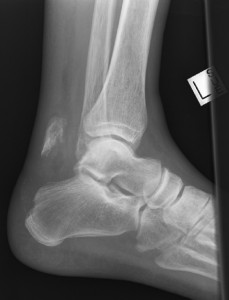Favre Fractures Found

The injuries keep piling up for 41 year old Minnesota Vikings quarterback Brett Favre. Earlier this month we talked about Favre’s elbow tendinitis. Now Vikings coach Brad Childress said an MRI on Favre’s foot revealed a stress fracture as well as an “avulsion” fracture in the heel bone. The injury could end “Ironman” Favre’s NFL-record run at 291 consecutive games started. As Childress stated: “He’s got great pain threshold and also great competitive zeal.” He also revealed that although surgery is not necessary at the present time, Favre may need surgery in the future to repair his injured ankle.
Stress fractures are overuse injuries. They are most common in the lower legs and feet of athletes, although almost anyone can get a stress fracture. When muscles become fatigued, they are unable to absorb shock as well. Eventually the muscles transfer the stress to the underlying bones, causing small cracks to form in the bone. Symptoms include pain, swelling, tenderness to touch at the site of the fracture. Diagnosis can be difficult, since X-rays may be called “negative” until evidence of bone healing begins three to six weeks after symptoms begin. Treatment using consists of rest, elevation, immobilization, and over-the-counter pain medications.
 An avulsion fracture is an injury to the bone in a place where a tendon or ligament attaches to the bone. When an avulsion fracture occurs, the tendon or ligament pulls off a piece of the bone. Avulsion fractures only account for 3% of fractures in the heel. They can occur by an acute over-pull of the achilles tendon (heelcord), usually during a major effort in sports or jumping or can be the result of a stress fracture from repetitive injury. The usual treatment for a small avulsion fracture includes icing and resting the affected area. Surgery may be necessary:
An avulsion fracture is an injury to the bone in a place where a tendon or ligament attaches to the bone. When an avulsion fracture occurs, the tendon or ligament pulls off a piece of the bone. Avulsion fractures only account for 3% of fractures in the heel. They can occur by an acute over-pull of the achilles tendon (heelcord), usually during a major effort in sports or jumping or can be the result of a stress fracture from repetitive injury. The usual treatment for a small avulsion fracture includes icing and resting the affected area. Surgery may be necessary:
- If a larger section of bone is involved
- There is a larger displacement of the bone fragments (the two parts of the fracture are far apart)
- There is also more severe tendon or ligament damage
(above): an avulsion fracture of the heel
For more information about stress fractures, click here to go to the Resounding Health Casebook on the topic.
























0 comments